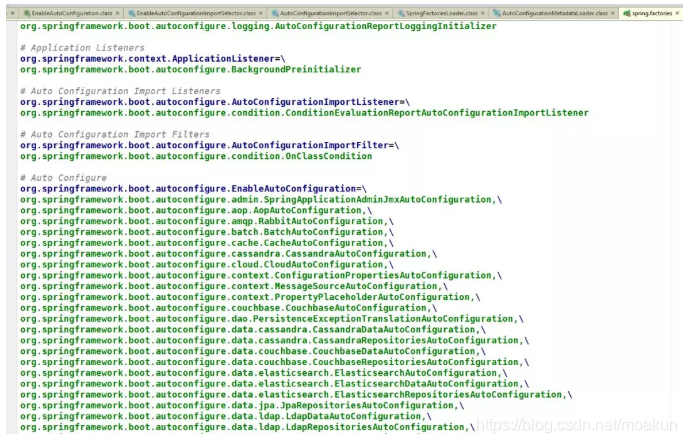转载自 Spring Boot 自动配置的 “魔法” 是如何实现的?
Spring Boot是Spring旗下众多的子项目之一,其理念是约定优于配置,它通过实现了自动配置(大多数用户平时习惯设置的配置作为默认配置)的功能来为用户快速构建出标准化的应用。Spring Boot的特点可以概述为如下几点:
-
内置了嵌入式的Tomcat、Jetty等Servlet容器,应用可以不用打包成War格式,而是可以直接以Jar格式运行。
-
提供了多个可选择的”starter”以简化Maven的依赖管理(也支持Gradle),让您可以按需加载需要的功能模块。
-
尽可能地进行自动配置,减少了用户需要动手写的各种冗余配置项,Spring Boot提倡无XML配置文件的理念,使用Spring Boot生成的应用完全不会生成任何配置代码与XML配置文件。
-
提供了一整套的对应用状态的监控与管理的功能模块(通过引入spring-boot-starter-actuator),包括应用的线程信息、内存信息、应用是否处于健康状态等,为了满足更多的资源监控需求,Spring Cloud中的很多模块还对其进行了扩展。
有关Spring Boot的使用方法就不做多介绍了,如有兴趣请自行阅读官方文档Spring Boot或其他文章。
如今微服务的概念愈来愈热,转型或尝试微服务的团队也在如日渐增,而对于技术选型,Spring Cloud是一个比较好的选择,它提供了一站式的分布式系统解决方案,包含了许多构建分布式系统与微服务需要用到的组件,例如服务治理、API网关、配置中心、消息总线以及容错管理等模块。可以说,Spring Cloud”全家桶”极其适合刚刚接触微服务的团队。似乎有点跑题了,不过说了这么多,我想要强调的是,Spring Cloud中的每个组件都是基于Spring Boot构建的,而理解了Spring Boot的自动配置的原理,显然也是有好处的。
Spring Boot的自动配置看起来神奇,其实原理非常简单,背后全依赖于@Conditional注解来实现的。
本文作者为SylvanasSun(sylvanas.sun@gmail.com),首发于SylvanasSun’s Blog。
原文链接:https://sylvanassun.github.io/2018/01/08/2018-01-08-spring_boot_auto_configure/
什么是@Conditional?
@Conditional是由Spring 4提供的一个新特性,用于根据特定条件来控制Bean的创建行为。而在我们开发基于Spring的应用的时候,难免会需要根据条件来注册Bean。
例如,你想要根据不同的运行环境,来让Spring注册对应环境的数据源Bean,对于这种简单的情况,完全可以使用@Profile注解实现,就像下面代码所示:
@Configurationpublic class AppConfig {@Bean@Profile("DEV")public DataSource devDataSource() {...}@Bean@Profile("PROD")public DataSource prodDataSource() {...}}剩下只需要设置对应的Profile属性即可,设置方法有如下三种:
-
通过context.getEnvironment().setActiveProfiles("PROD")来设置Profile属性。
-
通过设定jvm的spring.profiles.active参数来设置环境(Spring Boot中可以直接在application.properties配置文件中设置该属性)。
-
通过在DispatcherServlet的初始参数中设置。
<servlet><servlet-name>dispatcher</servlet-name><servlet-class>org.springframework.web.servlet.DispatcherServlet</servlet-class><init-param><param-name>spring.profiles.active</param-name><param-value>PROD</param-value></init-param></servlet>但这种方法只局限于简单的情况,而且通过源码我们可以发现@Profile自身也使用了@Conditional注解。
package org.springframework.context.annotation;@Target({ElementType.TYPE, ElementType.METHOD})@Retention(RetentionPolicy.RUNTIME)@Documented@Conditional({ProfileCondition.class}) // 组合了Conditional注解public @interface Profile {String[] value();}package org.springframework.context.annotation;class ProfileCondition implements Condition {ProfileCondition() {}// 通过提取出@Profile注解中的value值来与profiles配置信息进行匹配public boolean matches(ConditionContext context, AnnotatedTypeMetadata metadata) {if(context.getEnvironment() != null) {MultiValueMap attrs = metadata.getAllAnnotationAttributes(Profile.class.getName());if(attrs != null) {Iterator var4 = ((List)attrs.get("value")).iterator();Object value;do {if(!var4.hasNext()) {return false;}value = var4.next();} while(!context.getEnvironment().acceptsProfiles((String[])((String[])value)));return true;}}return true;}}在业务复杂的情况下,显然需要使用到@Conditional注解来提供更加灵活的条件判断,例如以下几个判断条件:
-
在类路径中是否存在这样的一个类。
-
在Spring容器中是否已经注册了某种类型的Bean(如未注册,我们可以让其自动注册到容器中,上一条同理)。
-
一个文件是否在特定的位置上。
-
一个特定的系统属性是否存在。
-
在Spring的配置文件中是否设置了某个特定的值。
举个栗子,假设我们有两个基于不同数据库实现的DAO,它们全都实现了UserDao,其中JdbcUserDAO与MySql进行连接,MongoUserDAO与MongoDB进行连接。现在,我们有了一个需求,需要根据命令行传入的系统参数来注册对应的UserDao,就像java -jar app.jar -DdbType=MySQL会注册JdbcUserDao,而java -jar app.jar -DdbType=MongoDB则会注册MongoUserDao。使用@Conditional可以很轻松地实现这个功能,仅仅需要在你自定义的条件类中去实现Condition接口,让我们来看下面的代码。(以下案例来自:https://dzone.com/articles/how-springboot-autoconfiguration-magic-works)
public interface UserDAO {....}public class JdbcUserDAO implements UserDAO {....}public class MongoUserDAO implements UserDAO {....}public class MySQLDatabaseTypeCondition implements Condition {@Overridepublic boolean matches(ConditionContext conditionContext, AnnotatedTypeMetadata metadata) {String enabledDBType = System.getProperty("dbType"); // 获得系统参数 dbType// 如果该值等于MySql,则条件成立return (enabledDBType != null && enabledDBType.equalsIgnoreCase("MySql"));}}// 与上述逻辑一致public class MongoDBDatabaseTypeCondition implements Condition {@Overridepublic boolean matches(ConditionContext conditionContext, AnnotatedTypeMetadata metadata) {String enabledDBType = System.getProperty("dbType");return (enabledDBType != null && enabledDBType.equalsIgnoreCase("MongoDB"));}}// 根据条件来注册不同的Bean@Configurationpublic class AppConfig {@Bean@Conditional(MySQLDatabaseTypeCondition.class)public UserDAO jdbcUserDAO() {return new JdbcUserDAO();}@Bean@Conditional(MongoDBDatabaseTypeCondition.class)public UserDAO mongoUserDAO() {return new MongoUserDAO();}}现在,我们又有了一个新需求,我们想要根据当前工程的类路径中是否存在MongoDB的驱动类来确认是否注册MongoUserDAO。为了实现这个需求,可以创建检查MongoDB驱动是否存在的两个条件类。
public class MongoDriverPresentsCondition implements Condition {@Overridepublic boolean matches(ConditionContext conditionContext, AnnotatedTypeMetadata metadata) {try {Class.forName("com.mongodb.Server");return true;} catch (ClassNotFoundException e) {return false;}}}public class MongoDriverNotPresentsCondition implements Condition {@Overridepublic boolean matches(ConditionContext conditionContext, AnnotatedTypeMetadata metadata) {try {Class.forName("com.mongodb.Server");return false;} catch (ClassNotFoundException e) {return true;}}}假如,你想要在UserDAO没有被注册的情况下去注册一个UserDAOBean,那么我们可以定义一个条件类来检查某个类是否在容器中已被注册。public class UserDAOBeanNotPresentsCondition implements Condition {@Overridepublic boolean matches(ConditionContext conditionContext, AnnotatedTypeMetadata metadata) {UserDAO userDAO = conditionContext.getBeanFactory().getBean(UserDAO.class);return (userDAO == null);}}如果你想根据配置文件中的某项属性来决定是否注册MongoDAO,例如app.dbType是否等于MongoDB,我们可以实现以下的条件类。
public class MongoDbTypePropertyCondition implements Condition {@Overridepublic boolean matches(ConditionContext conditionContext, AnnotatedTypeMetadata metadata) {String dbType = conditionContext.getEnvironment().getProperty("app.dbType");return "MONGO".equalsIgnoreCase(dbType);}}我们已经尝试并实现了各种类型的条件判断,接下来,我们可以选择一种更为优雅的方式,就像@Profile一样,以注解的方式来完成条件判断。首先,我们需要定义一个注解类。
@Target({ ElementType.TYPE, ElementType.METHOD })@Retention(RetentionPolicy.RUNTIME)@Documented@Conditional(DatabaseTypeCondition.class)public @interface DatabaseType {String value();}具体的条件判断逻辑在DatabaseTypeCondition类中,它会根据系统参数dbType来判断注册哪一个Bean。
public class DatabaseTypeCondition implements Condition {@Overridepublic boolean matches(ConditionContext conditionContext, AnnotatedTypeMetadata metadata) {Map<String, Object> attributes = metadata.getAnnotationAttributes(DatabaseType.class.getName());String type = (String) attributes.get("value");// 默认值为MySqlString enabledDBType = System.getProperty("dbType", "MySql");return (enabledDBType != null && type != null && enabledDBType.equalsIgnoreCase(type));}}最后,在配置类应用该注解即可。
@Configuration@ComponentScanpublic class AppConfig {@Bean@DatabaseType("MySql")public UserDAO jdbcUserDAO() {return new JdbcUserDAO();}@Bean@DatabaseType("mongoDB")public UserDAO mongoUserDAO() {return new MongoUserDAO();}}
AutoConfigure源码分析
通过了解@Conditional注解的机制其实已经能够猜到自动配置是如何实现的了,接下来我们通过源码来看看它是怎么做的。本文中讲解的源码基于Spring Boot 1.5.9版本(最新的正式版本)。
使用过Spring Boot的童鞋应该都很清楚,它会替我们生成一个入口类,其命名规格为ArtifactNameApplication,通过这个入口类,我们可以发现一些信息。
@SpringBootApplicationpublic class DemoApplication {public static void main(String[] args) {SpringApplication.run(DemoApplication.class, args);}}首先该类被@SpringBootApplication注解修饰,我们可以先从它开始分析,查看源码后可以发现它是一个包含许多注解的组合注解。
@Target({ElementType.TYPE})@Retention(RetentionPolicy.RUNTIME)@Documented@Inherited@SpringBootConfiguration@EnableAutoConfiguration@ComponentScan(excludeFilters = {@Filter(type = FilterType.CUSTOM,classes = {TypeExcludeFilter.class}), @Filter(type = FilterType.CUSTOM,classes = {AutoConfigurationExcludeFilter.class})})public @interface SpringBootApplication {@AliasFor(annotation = EnableAutoConfiguration.class,attribute = "exclude")Class<?>[] exclude() default {};@AliasFor(annotation = EnableAutoConfiguration.class,attribute = "excludeName")String[] excludeName() default {};@AliasFor(annotation = ComponentScan.class,attribute = "basePackages")String[] scanBasePackages() default {};@AliasFor(annotation = ComponentScan.class,attribute = "basePackageClasses")Class<?>[] scanBasePackageClasses() default {};}该注解相当于同时声明了@Configuration、@EnableAutoConfiguration与@ComponentScan三个注解(如果我们想定制自定义的自动配置实现,声明这三个注解就足够了),而@EnableAutoConfiguration是我们的关注点,从它的名字可以看出来,它是用来开启自动配置的,源码如下:
@Target({ElementType.TYPE})@Retention(RetentionPolicy.RUNTIME)@Documented@Inherited@AutoConfigurationPackage@Import({EnableAutoConfigurationImportSelector.class})public @interface EnableAutoConfiguration {String ENABLED_OVERRIDE_PROPERTY = "spring.boot.enableautoconfiguration";Class<?>[] exclude() default {};String[] excludeName() default {};}我们发现@Import(Spring 提供的一个注解,可以导入配置类或者Bean到当前类中)导入了EnableAutoConfigurationImportSelector类,根据名字来看,它应该就是我们要找到的目标了。不过查看它的源码发现它已经被Deprecated了,而官方API中告知我们去查看它的父类AutoConfigurationImportSelector。
/** @deprecated */@Deprecatedpublic class EnableAutoConfigurationImportSelector extends AutoConfigurationImportSelector {public EnableAutoConfigurationImportSelector() {}protected boolean isEnabled(AnnotationMetadata metadata) {return this.getClass().equals(EnableAutoConfigurationImportSelector.class)?((Boolean)this.getEnvironment().getProperty("spring.boot.enableautoconfiguration", Boolean.class, Boolean.valueOf(true))).booleanValue():true;}}由于AutoConfigurationImportSelector的源码太长了,这里我只截出关键的地方,显然方法selectImports是选择自动配置的主入口,它调用了其他的几个方法来加载元数据等信息,最后返回一个包含许多自动配置类信息的字符串数组。
public String[] selectImports(AnnotationMetadata annotationMetadata) {if(!this.isEnabled(annotationMetadata)) {return NO_IMPORTS;} else {try {AutoConfigurationMetadata ex = AutoConfigurationMetadataLoader.loadMetadata(this.beanClassLoader);AnnotationAttributes attributes = this.getAttributes(annotationMetadata);List configurations = this.getCandidateConfigurations(annotationMetadata, attributes);configurations = this.removeDuplicates(configurations);configurations = this.sort(configurations, ex);Set exclusions = this.getExclusions(annotationMetadata, attributes);this.checkExcludedClasses(configurations, exclusions);configurations.removeAll(exclusions);configurations = this.filter(configurations, ex);this.fireAutoConfigurationImportEvents(configurations, exclusions);return (String[])configurations.toArray(new String[configurations.size()]);} catch (IOException var6) {throw new IllegalStateException(var6);}}}重点在于方法getCandidateConfigurations()返回了自动配置类的信息列表,而它通过调用SpringFactoriesLoader.loadFactoryNames()来扫描加载含有META-INF/spring.factories文件的jar包,该文件记录了具有哪些自动配置类。(建议还是用IDE去看源码吧,这些源码单行实在太长了,估计文章中的观看效果很差)
protected List<String> getCandidateConfigurations(AnnotationMetadata metadata, AnnotationAttributes attributes) {List configurations = SpringFactoriesLoader.loadFactoryNames(this.getSpringFactoriesLoaderFactoryClass(), this.getBeanClassLoader());Assert.notEmpty(configurations, "No auto configuration classes found in META-INF spring.factories. If you are using a custom packaging, make sure that file is correct.");return configurations;}public static List<String> loadFactoryNames(Class<?> factoryClass, ClassLoader classLoader) {String factoryClassName = factoryClass.getName();try {Enumeration ex = classLoader != null?classLoader.getResources("META-INF/spring.factories"):ClassLoader.getSystemResources("META-INF/spring.factories");ArrayList result = new ArrayList();while(ex.hasMoreElements()) {URL url = (URL)ex.nextElement();Properties properties = PropertiesLoaderUtils.loadProperties(new UrlResource(url));String factoryClassNames = properties.getProperty(factoryClassName);result.addAll(Arrays.asList(StringUtils.commaDelimitedListToStringArray(factoryClassNames)));}return result;} catch (IOException var8) {throw new IllegalArgumentException("Unable to load [" + factoryClass.getName() + "] factories from location [" + "META-INF/spring.factories" + "]", var8);}}
自动配置类中的条件注解
接下来,我们在spring.factories文件中随便找一个自动配置类,来看看是怎样实现的。我查看了MongoDataAutoConfiguration的源码,发现它声明了@ConditionalOnClass注解,通过看该注解的源码后可以发现,这是一个组合了@Conditional的组合注解,它的条件类是OnClassCondition。
@Configuration@ConditionalOnClass({Mongo.class, MongoTemplate.class})@EnableConfigurationProperties({MongoProperties.class})@AutoConfigureAfter({MongoAutoConfiguration.class})public class MongoDataAutoConfiguration {....}@Target({ElementType.TYPE, ElementType.METHOD})@Retention(RetentionPolicy.RUNTIME)@Documented@Conditional({OnClassCondition.class})public @interface ConditionalOnClass {Class<?>[] value() default {};String[] name() default {};}然后,我们开始看OnClassCondition的源码,发现它并没有直接实现Condition接口,只好往上找,发现它的父类SpringBootCondition实现了Condition接口。
class OnClassCondition extends SpringBootCondition implements AutoConfigurationImportFilter, BeanFactoryAware, BeanClassLoaderAware {.....}public abstract class SpringBootCondition implements Condition {private final Log logger = LogFactory.getLog(this.getClass());public SpringBootCondition() {}public final boolean matches(ConditionContext context, AnnotatedTypeMetadata metadata) {String classOrMethodName = getClassOrMethodName(metadata);try {ConditionOutcome ex = this.getMatchOutcome(context, metadata);this.logOutcome(classOrMethodName, ex);this.recordEvaluation(context, classOrMethodName, ex);return ex.isMatch();} catch (NoClassDefFoundError var5) {throw new IllegalStateException("Could not evaluate condition on " + classOrMethodName + " due to " + var5.getMessage() + " not found. Make sure your own configuration does not rely on that class. This can also happen if you are @ComponentScanning a springframework package (e.g. if you put a @ComponentScan in the default package by mistake)", var5);} catch (RuntimeException var6) {throw new IllegalStateException("Error processing condition on " + this.getName(metadata), var6);}}public abstract ConditionOutcome getMatchOutcome(ConditionContext var1, AnnotatedTypeMetadata var2);}SpringBootCondition实现的matches方法依赖于一个抽象方法this.getMatchOutcome(context, metadata),我们在它的子类OnClassCondition中可以找到这个方法的具体实现。
public ConditionOutcome getMatchOutcome(ConditionContext context, AnnotatedTypeMetadata metadata) {ClassLoader classLoader = context.getClassLoader();ConditionMessage matchMessage = ConditionMessage.empty();// 找出所有ConditionalOnClass注解的属性List onClasses = this.getCandidates(metadata, ConditionalOnClass.class);List onMissingClasses;if(onClasses != null) {// 找出不在类路径中的类onMissingClasses = this.getMatches(onClasses, OnClassCondition.MatchType.MISSING, classLoader);// 如果存在不在类路径中的类,匹配失败if(!onMissingClasses.isEmpty()) {return ConditionOutcome.noMatch(ConditionMessage.forCondition(ConditionalOnClass.class, new Object[0]).didNotFind("required class", "required classes").items(Style.QUOTE, onMissingClasses));}matchMessage = matchMessage.andCondition(ConditionalOnClass.class, new Object[0]).found("required class", "required classes").items(Style.QUOTE, this.getMatches(onClasses, OnClassCondition.MatchType.PRESENT, classLoader));}// 接着找出所有ConditionalOnMissingClass注解的属性// 它与ConditionalOnClass注解的含义正好相反,所以以下逻辑也与上面相反onMissingClasses = this.getCandidates(metadata, ConditionalOnMissingClass.class);if(onMissingClasses != null) {List present = this.getMatches(onMissingClasses, OnClassCondition.MatchType.PRESENT, classLoader);if(!present.isEmpty()) {return ConditionOutcome.noMatch(ConditionMessage.forCondition(ConditionalOnMissingClass.class, new Object[0]).found("unwanted class", "unwanted classes").items(Style.QUOTE, present));}matchMessage = matchMessage.andCondition(ConditionalOnMissingClass.class, new Object[0]).didNotFind("unwanted class", "unwanted classes").items(Style.QUOTE, this.getMatches(onMissingClasses, OnClassCondition.MatchType.MISSING, classLoader));}return ConditionOutcome.match(matchMessage);}// 获得所有annotationType注解的属性private List<String> getCandidates(AnnotatedTypeMetadata metadata, Class<?> annotationType) {MultiValueMap attributes = metadata.getAllAnnotationAttributes(annotationType.getName(), true);ArrayList candidates = new ArrayList();if(attributes == null) {return Collections.emptyList();} else {this.addAll(candidates, (List)attributes.get("value"));this.addAll(candidates, (List)attributes.get("name"));return candidates;}}private void addAll(List<String> list, List<Object> itemsToAdd) {if(itemsToAdd != null) {Iterator var3 = itemsToAdd.iterator();while(var3.hasNext()) {Object item = var3.next();Collections.addAll(list, (String[])((String[])item));}}} // 根据matchType.matches方法来进行匹配private List<String> getMatches(Collection<String> candidates, OnClassCondition.MatchType matchType, ClassLoader classLoader) {ArrayList matches = new ArrayList(candidates.size());Iterator var5 = candidates.iterator();while(var5.hasNext()) {String candidate = (String)var5.next();if(matchType.matches(candidate, classLoader)) {matches.add(candidate);}}return matches;}关于match的具体实现在MatchType中,它是一个枚举类,提供了PRESENT和MISSING两种实现,前者返回类路径中是否存在该类,后者相反。
private static enum MatchType {PRESENT {public boolean matches(String className, ClassLoader classLoader) {return OnClassCondition.MatchType.isPresent(className, classLoader);}},MISSING {public boolean matches(String className, ClassLoader classLoader) {return !OnClassCondition.MatchType.isPresent(className, classLoader);}};private MatchType() {}// 跟我们之前看过的案例一样,都利用了类加载功能来进行判断private static boolean isPresent(String className, ClassLoader classLoader) {if(classLoader == null) {classLoader = ClassUtils.getDefaultClassLoader();}try {forName(className, classLoader);return true;} catch (Throwable var3) {return false;}}private static Class<?> forName(String className, ClassLoader classLoader) throws ClassNotFoundException {return classLoader != null?classLoader.loadClass(className):Class.forName(className);}public abstract boolean matches(String var1, ClassLoader var2);}现在终于真相大白,@ConditionalOnClass的含义是指定的类必须存在于类路径下,MongoDataAutoConfiguration类中声明了类路径下必须含有Mongo.class, MongoTemplate.class这两个类,否则该自动配置类不会被加载。
在Spring Boot中到处都有类似的注解,像@ConditionalOnBean(容器中是否有指定的Bean),@ConditionalOnWebApplication(当前工程是否为一个Web工程)等等,它们都只是@Conditional注解的扩展。当你揭开神秘的面纱,去探索本质时,发现其实Spring Boot自动配置的原理就是如此简单,在了解这些知识后,你完全可以自己去实现自定义的自动配置类,然后编写出自定义的starter。
)

![学习ASP.NET Core,怎能不了解请求处理管道[2]: 服务器在管道中的“龙头”地位](http://pic.xiahunao.cn/学习ASP.NET Core,怎能不了解请求处理管道[2]: 服务器在管道中的“龙头”地位)

)

)
![学习ASP.NET Core,怎能不了解请求处理管道[1]: 中间件究竟是个什么东西?](http://pic.xiahunao.cn/学习ASP.NET Core,怎能不了解请求处理管道[1]: 中间件究竟是个什么东西?)

)


![P1463-[POI2002][HAOI2007]反素数【约数,数论】](http://pic.xiahunao.cn/P1463-[POI2002][HAOI2007]反素数【约数,数论】)

)


![JS中 [] == ![]结果为true,而 {} == !{}却为false, 追根刨底](http://pic.xiahunao.cn/JS中 [] == ![]结果为true,而 {} == !{}却为false, 追根刨底)
![P2261-[CQOI2007]余数求和【数论,约数】](http://pic.xiahunao.cn/P2261-[CQOI2007]余数求和【数论,约数】)
